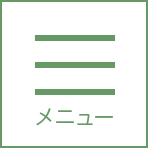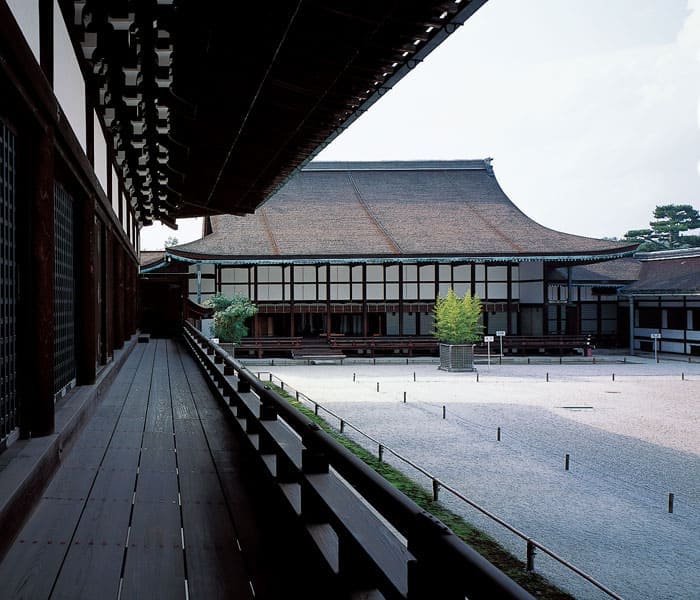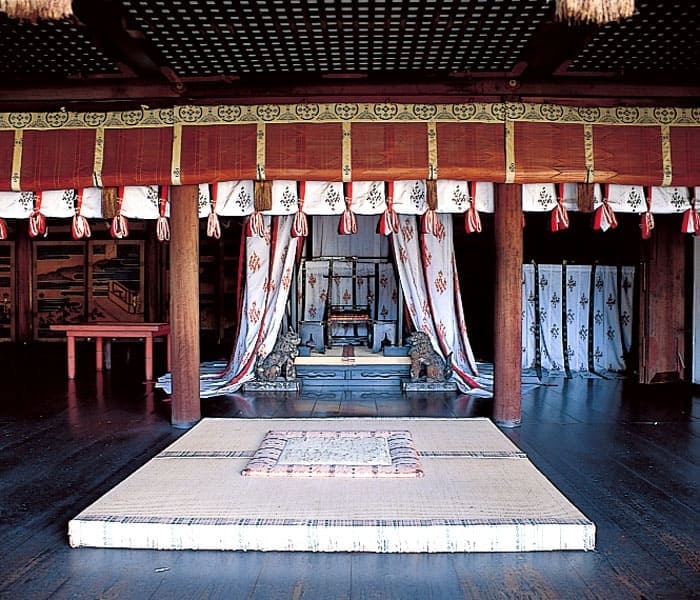京都御所Kyoto Imperial Palace
御車寄Okurumayose
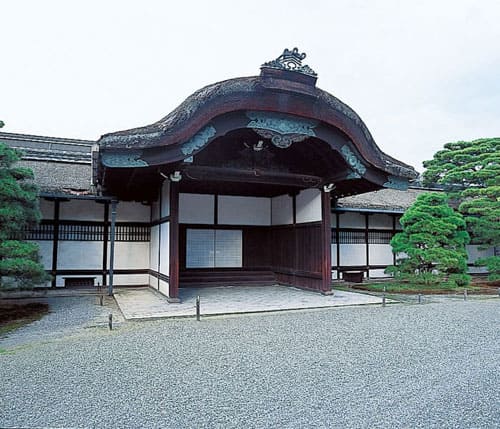
昇殿を許された者が正式な参内の時の玄関であり,屋根は檜皮葺で優雅な反りをなしている。
This was the entrance used for official visits by courtiers who had been granted permission to enter the Palace precincts.
諸大夫の間Shodaibunoma
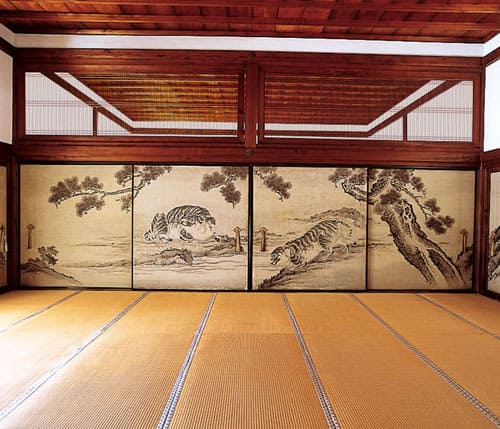
正式な用向きで参内した時の控えの建物。最も格の高い「公卿の間」,諸侯・所司代の控えの「殿上人の間」,それ以外の者の控えの「諸大夫の間」の三室からなり,それぞれ襖の絵にちなんで「虎の間」(岸岱筆),「鶴の間」(狩野永岳筆),「桜の間」(原在照筆)とも呼ばれている。
This building was used as a waiting area for courtiers paying official visits to the Palace. There are three rooms named after the objects painted on the fusuma sliding door: the Tiger Room, Crane Room and Cherry Room. Courtiers rested or waited in different rooms according to rank.
紫宸殿Shishinden
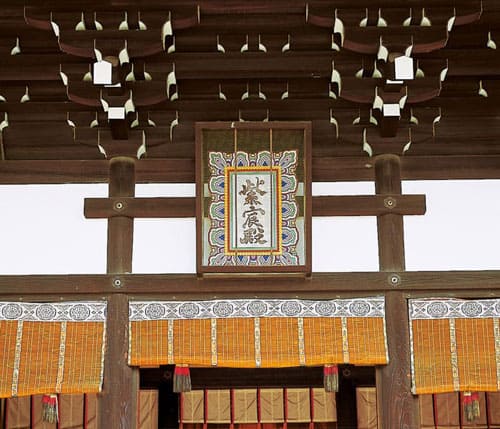
安政2年(1855年)に再建された紫宸殿は,即位礼などの重要な儀式を執り行う最も格式の高い正殿であり,京都御所の象徴ともいえる存在である。大正天皇・昭和天皇の即位礼もここで行われた。
入母屋檜皮葺の高床式宮殿建築で,間口約37.0m,奥行き約26.3m,棟高20.5mの純木造平屋建てである。正面に十八段の階段を有し,四方に高欄を付けた簀子をめぐらしている。内部は寝殿造りの例により中央の母屋の四囲に廂があり,母屋と北廂の間は絹張り襖の賢聖障子で仕切られ,天井板はなく化粧屋根裏である。四囲は胡粉の白塗り地板に黒漆塗りの桟で格子を組んだ蔀戸で,開けるときは内側に金物で釣り上げる。
六枚の板を透し張りにした簀子の正面上にある紫宸殿の扁額は,岡本保考の筆で,嘉永時の炎上のときに賢聖障子と共に類焼をまぬがれている。階段脇には,東に左近の桜,西に右近の橘があり,前面には白砂の南庭が広がり,建物と同様に庭も重要な役割を果たしている。
The Shishinden, which was rebuilt in 1855, is the most important building on the Palace
grounds, and was used for important ceremonies of state such as enthronement ceremonies. The
Shishinden is the symbol of the Kyoto Imperial
Palace and the enthronement ceremonies of Emperors Taisho and Showa were held here. The
Shishinden is a one-story building purely made of wood. It was built in the architectural
design of the irimoya(hipped and gabled roof)
and Imperial Palace-style with high flooring. Its roof is made of hiwada, or layers of
cypress bark. The building measures 37.7m in width and 20.5m in height. All around the
building, there are shitomido(latticed shutters),
which are suspended from iron hooks that are attached to the inside of the building. There
are 18 steps leading up to the main entrance of the building. The slatted piece of flooring
composed of six planks of wood, hanging
in a frame over the main entrance, is an item that survived the 1854 fire.
On the side
of the stairs leading to the entrance, there is a cherry tree to the east and a tachibana
orange tree to the west. To the front of the
Shishinden there is an inner south garden laid with white sand. This garden, like the
structure itself, serves an important role in ceremonies.
高御座と御帳台Takamikura and Michodai
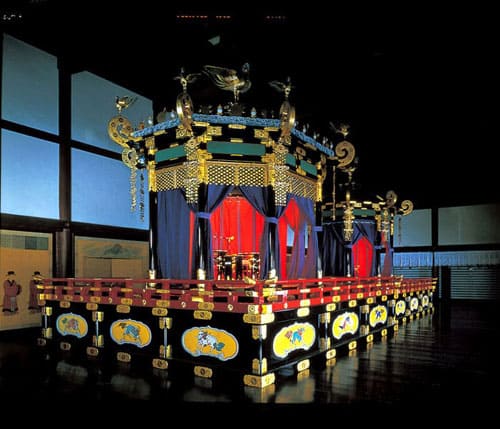
紫宸殿母屋中央,浜床の上に厚畳2枚を敷き,その上に御倚子,向かって右に剣璽案(台),左に式の筥を置く案を据え,八角形の黒塗り屋形の上に鳳凰を頂く天皇の御座「高御座」,その東に鸞鳥を頂く皇后の御座「御帳台」が置かれている。現在の高御座と御帳台は,大正4年(1915年)11月の大正天皇の即位礼に際し,古制に従って造られたものであり,今上陛下の即位礼には,東京に搬送し宮殿で使用された。
These structures are located in the center of the Shishinden. They are the Imperial thrones for the Emperor and Empress respectively and are used on the occasion of ceremony of enthronement. The Takamikura and Michodai were constructed in the traditional style for the ceremony of enthronement of Emperor Taisho in 1915. These Imperial thrones were brought to Tokyo for the ceremony of enthronement of His Majesty Emperor Naruhito.
清涼殿Seiryoden
紫宸殿の背後の北西部に東面して建ち,別棟として御常御殿が建てられるまでの永い間,天皇の日常の御生活の場として使用されていた。被災や寺社ヘの下賜により建替えを繰り返し,現在のものは平安時代の内裏のものより小さくなっているが,比較的よく古制を伝えている。清涼殿の東側に広がる東庭は,白砂敷きで,正面に呉竹,南寄り軒下近くに漢竹が籬に囲まれて植えてある。北側に20cm程の落差のある滝口があり,そこから落ちた御溝水は,御溝に沿って楚々とした流れを作っている。
建物は,入母屋檜皮葺の寝殿造りで紫宸殿と同じであるが,床ははるかに低く,内部は間仕切りも多くなっていて,日常の御住居に適するように工夫されている。東側は弘廂といい,その北側には部屋に直角に立てられた絹張りの衝立昆明池障子(模造),南側には年中行事を記した障子(衝立)が用いられている。南廂を「殿上の間」といい,ここに蔵人や公卿などが伺候し奉仕した。殿上人というのは,ここに昇殿できる者のことである。東廂には,床を漆喰で固めた石灰壇,「昼御座」と呼ばれる昼の間の御座所,そして小部屋が二つ並んでいる。さらに奥の母屋には獅子狛犬に守られて御帳台が置かれ,天皇の御休息にあてられた。さらに,天皇の御寝室として四囲を壁で囲んだ塗籠造りの夜御殿がある。正面からはうかがい知れない西廂は,奥向きにふさわしく御湯殿上,御手水間,朝餉間などの部屋が並び萩壷に面している。
For a long time before the separate Otsunegoten was built, this structure was used as the
Emperor's residence. The structure is built in the traditional shinden style like the
Shishinden, but the floor is built much lower. The
building has many more internal partitions, making it more appropriate as a residence for
everyday life. This building is also renowned throughout Japanese literature. Perhaps the
best-known work in which Seiryoden is mentioned
is The Tale of Genji. Written by Murasaki Shikibu in the 11th century, this is a monumental
work that describes court life in the Heian period in minute and vivid detail.
The east
garden of Seiryoden is laid with white
sand. Two types of bamboo, kuretake and kawatake, are grown there.
小御所Kogosho
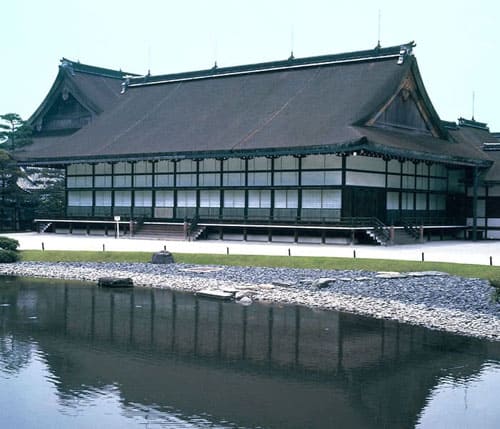
紫宸殿の北東,御池庭に面して建つ入母屋檜皮葺の小御所は,平安朝の内裏には見られない御殿である。元服(成年式)などの儀式に用いられ,また,天皇が将軍や諸侯と対面される場所ともされた。王政復古の大号令が発せられた後の「小御所会議」は慶応3年12月9日の夜,ここで行われた。寝殿造りを基本にしながら,母屋は三室に仕切られ,畳を敷きつめて天井を張った書院造り風になっている。蔀は半蔀で上部を外側に釣り上げ,下部ははめ込み式である。昭和29年に焼失,昭和33年に復元されたものである。
This structure was used in ceremonies such as the Coming-of Age Ceremony and on occasions when the Emperor received the Shogun or Daimyos. The Kogosho Conference, a crucial conference in which an order was given to restore Imperial Rule, thus changing the course of Japanese history, was held here in 1868, a year before the Emperor moved his residence to Tokyo. Kogosho was destroyed by fire in 1954 and rebuilt in 1958.
御学問所Ogakumonj
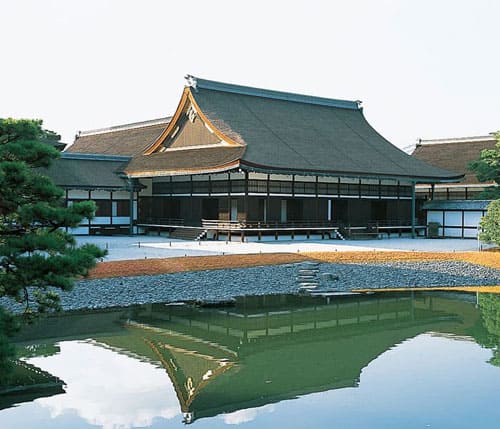
小御所の北に位置し,蹴鞠の庭をはさんで東に面し,入母屋檜皮葺の御殿である。格子の蔀に代えて舞良戸(遣戸,引戸)で四囲を閉ざす点や,床や違い棚を備えている点で,一層書院造りに近い建築様式である。必ずしも学問のためだけの御殿ではなく,和歌の会などにも用いられた。
Situated to the north of the Kogosho, this structure faces east with the kemari garden (See following explanation) in between. It was built in an architectural design similar to the shoin style, with a floor and alcove shelves. It was used by the Emperor for study of such matters as politics, and was also used for poetry readings, where waka (a 31-syllable poem) would be read.
蹴鞠Kemari

昔の貴人の遊び。鹿革で作った鞠を数人で地面に落さないよう蹴って遊ぶ。小御所と御学問所の間の四角い庭を鞠懸,また蹴鞠の庭という。
Kemari is a game that was played by Palace courtiers and this is the space in which it was played. The game was playe with a ball made of deerskin and the objective was to pass the ball to one another while trying to keep the ball from falling to the ground. The kemari tradition has been passed down through the ages and is still played on occasion.
御池庭Oikeniwa Garden
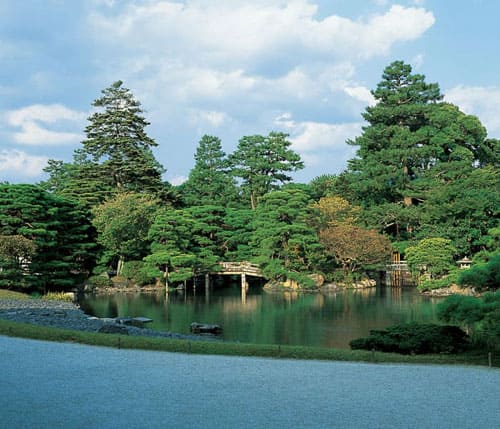
文字通り大きい池を中心とした回遊式庭園で,前面には洲浜があり,その中に飛石を配して舟着きに導いている。右手にゆったりと弧を描いた欅橋が架かり,対岸にはこんもり繁る樹木を配し,苑路から様々に変化する景色を楽しむことができる。
The Oikeniwa Garden is a strolling garden, the main feature of which is a large pond with an artificial shoreline toward the front and stepping stones across to a boat mooring place. There is an arc-shaped Keyakibashi Bridge that stretches across the pond. It is possible to enjoy this beautiful scenery from many different angles along the shore.
御常御殿Otsunegoten
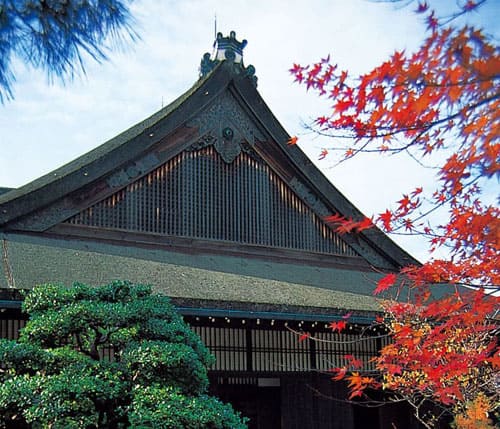
御学問所の北に位置し,京都御所の中で最も大きな御殿で,内部は十五室の書院造りの様式である。天皇が日常生活を営まれる御殿は,平安遷都当初の仁寿殿から清涼殿に移ったが,やがて清涼殿も居住様式の変化に対応できなくなったことから,豊臣秀吉の行った天正度の造営に際して,御常御殿が別棟として建てられるようになった。安政2年(1855年)の再建になる現在の御常御殿は,実用性を重んじ機能的な造りに加え,剣璽を奉安する「剣璽の間」など格式のある間も備えられている。御常御殿から奥(北側)はいわゆる奥向きの御殿といわれている。
Located to the north of the Ogakumonjo, the Otsunegoten is the largest structure in the Palace grounds. It has 15 rooms and is built in the shoin style. There is a room called the Kenji-noma in which the sword and seal, the symbols of the Imperial Throne, were preserved. The Emperor formerly used the Seiryoden as a place for daily life, but when Imperial Palace was restored at the end of the 16th century, the Otsunegoten was newly constructed reflecting the architectural style of the period. Thereafter the Emperors lived here until the capital was transferred to Tokyo in 1869.

